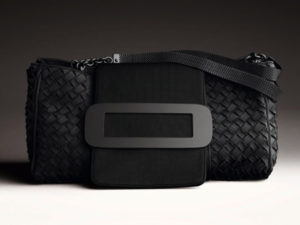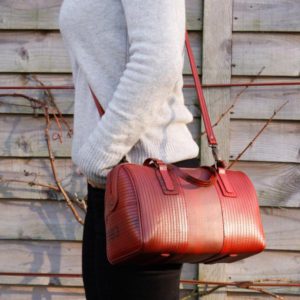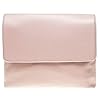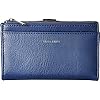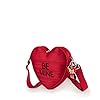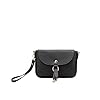The Ultimate Guide to Vegan Leather Alternatives
Leather is a classic, durable material, that has been used by humans for thousands of years. As more and more people, however, choose to follow a vegan or simply more conscious lifestyle, the demand for cruelty-free alternatives is on the rise. While leather was a merely a by-product of food in the early days of humankind, leather production these days has a high carbon footprint and the conditions under which animal leather is produced and dyed are often detrimental to workers’ health. Mass production has led to factory farming and when confronted with the horrific images documenting the process, many start to look what else is out there.
When it comes to bags, it has long been a trade-off between style and a clear conscience. When Stella McCartney started to gain traction with her line of cruelty-free bags, many were curious and celebrated the designers’ engagement. Her early success has inspired many other designers to follow in her footsteps and these days, when looking for a vegan designer bag, the choice is big. The market, however, is fragmented and it can be difficult at times to get an overview of all options. Different styles, different materials, different philosophies. There’s a lot of bags to choose from and one starts to wonder: Is leather still necessary in fashion?
Many celebrate the rise of vegan alternatives to leather (and rightfully so), but when speaking of the benefits, one also has to mention the problems with materials like PVC, which, while vegan, are problematic, as their production can be far from eco-friendly.
In this detailed guide we aim to give you an overview of the history of leather, the alternatives and how to choose the right material for your first or next vegan bag. We’ll also talk about “the dark side” of vegan leather and introduce you to some innovative companies in the bio-tech space, who develop the next generation of sustainable vegan leather alternatives.
A Little History of Leather
The earliest records of leather artifacts date back to at least 2200 B.C. Our ancestors hunted animals for food and then used the hides to make clothing or footwear. Wall paintings in Egyptian tombs dating back to 5000 B.C. indicate that the material was also used in this ancient civilization. The Greeks figured out how to tan leather using vegetable-based dyes and the early Romans were very fond of their leather-made clothes, shoes, but also military apparel.
Throughout history leather has been appreciated for its durability and as industrialization spread starting in the 18th century more and more goods were made from “humankind’s favorite material”. Belts, seats for cars, high fashion, furniture – The demand for those new, innovative products led to a rising demand for leather as well. The tanning processed moved from being largely vegetable based to using chromium salt, which quickly became the standard. Those developments quickly led to more research and innovation in the leather industry.
The Development of Faux Leather
The American company DuPont is credited with the development of the first plastic-based materials in the 1920s and invented neopren, superpolymer, nylon and teflon. Their artifical leather, called Fabrikoid, was produced by coating fabric with nitrocellulose. The material was very popular throughout the early 20th century and was used in upholstery, luggage and the automotive industry as a premier choice for seat covers and such. Around the 1940s vinyl-coated fabrics overtook the market.
The fashion industry started to use plastic-based materials as they were cheap and did a great job imitating the looks and feel of natural leather. Besides the economic advantages, faux leathers were easy to clean, durable and largely resistant to cracking, which made them a great choice – for mass produced fashion, but also more and more high-end designers.
Faux Leather and the Environment
When Stella McCartney launched her line of cruelty-free bags, vegans stormed into the stores to get their own or at least get a peak of the bag, that’s been all over the news. Soon after the initial excitement wore off, some more critical voices started to surface.
The reason for this was the use of materials such as polyvinyl chloride (PVC) and polyurethane (PU), which, although vegan, may not be the more eco-friendly choice because of their heavy reliance on petroleum. Furthermore the chemicals used during the production and tanning process are a risk to worker’s health and the environment alike.
Another reason for criticism are toxic chemicals like dioxins, which are a by-product of PVC production and phthalates, a softening agent, which is often released once the vegan leather starts cracking. Both chemicals are known to have serious consequences for the health and are often associated with cancer and hormonal issues.
Many argue that PU is a more eco-friendly alternative to PVC. The production of PU, however, also requires the use of chemicals such as dimethyl formamide, which has also been linked to health issues.
The Rise of Eco-friendly Vegan Leather Alternatives
As awareness for the problems and cruelty associated with animal-based and plastic-based leather rises, more and more consumers actively seek out alternatives and more and more designers and high-end brands are starting to embrace innovative and eco-friendly materials.
While Stella McCartney is still considered a pioneer in the industry, others have built on her success ever since. Bag brand Gunas is well on the way to becoming a household name, Jill Milan bags make regular appearances on the red carpet and cult gaia’s Ark bag confidently claimed a spot on every IT-bag list there was last summer. The days where vegan bags were only available in hippie-chic are long gone.
(Image by Nuvi Nomad)
Many young and upcoming designers make a conscious choice to only work with cruelty-free materials, established brands are starting to realize, that offering vegan leather alternatives is good business. When exploring their options, creatives are met with a wealth of innovative, cruelty-free materials, that work with their designs.
Cork
Cork has long been considered one of the most eco-friendly materials used in fashion. Cork production has a long tradition in Portugal, where most of the material is harvested. A cork oak tree can be harvested every 10 years and during the harvesting process only the bark of the tree is removed, which means the tree can continue to grow. Once harvested the bark is dried out, boiled, compressed and can then be turned into a leather-like vegan material, that is used by designers in Portugal, but also internationally.
Some of the designer brands who use Cork in their creations are Eve or Portuguese Corkor. Bigger brands like Chanel have also experimented with the material.
Tree bark leather, which is made from sustainable timber and somewhat similar to cork, is sometimes used for shoes and bags. Designers like the natural and unique look of the material.
(Image by Corkor)
Teak Leaf Leather
Teak leaf leather is made from sustainably harvested Teak leaves, which are mended with fabric and sealed. It is a durable and water resistant material, that is produced in Northern Thailand. Like the leaves in nature every piece made from teak leaf leather is unique.
Both Tree Tribe and NUVI Nomad create stylish vegan bags made from this eco-friendly material.
(Image by NUVI NOMAD)
Mushroom Leather
Both Muskin and Mylo are eco-friendly vegan leather alternatives made from mushrooms. While Muskin is made from mushroom caps, Mylo uses the underground root structure of mushrooms to create their material. Stella McCartney and outdoor brand Patagonia are said to work with Bolt Threads Mylo.
Bolt Threads is currently running a kickstarter campaign, where backers can buy the first commercially available bag made from Mylo.
(Image by Bolt Threads)
Rubber (Recycled Tires)
Some designers reclaim old bus and truck tires and turn them into bags and jewelry. You will agree, that this kind of recycling is better than the old tires simply ending up in some landfill. Fashion brand Paguro works with this kind of recycled rubber.
 (Image by Paguro)
(Image by Paguro)
Naoron
Naoron is a flexible, water- and tear-resistant, paper-like material, that was developed by Onao in Japan. Onao is known for introducting the world to everyone’s favorite washi tapes. Naoron is derived from wood pulp and Polyolefin; traditional Japanese paper-manufacturing techniques are used for its production. To introduse the innovative material Onao collaborated with renowned Japanese designer Naoto Fukasawa to create the SIWA collection. The material has also been used by Bottega Veneta, who created a vegan bag made from the paper-based leather a while back.
(Image by Bottega Veneta)
Waxed Cotton
Waxed cotton is among the more common vegan leather alternatives. A lot of European designers like Trakke or upcoming brand Treesizeverse work with the material. The material is easy to clean and durable, which makes is a top pick for “everyday bags” like backpacks or messenger bags.
(Image by Trakke)
Pinatex
Pinatex is a rather new, natural material made from pineapple leaf fibres, which are a by-product of the pineapple harvest. One of the first brands to use the innovative material is Svala, a well-know vegan bag brand from Los Angeles.
(Image by Svala)
Apple Peel Leather
Philadelphia based brand Veggani uses apple peel leather for their designs. The apple peels are dried, powdered, mixed with vegan glue and rolled into sheets.
But apples are not the only fruit used to imitate leather. A Dutch design duo launched Fruit Leather Rotterdam a while back and Salavatore Ferragamo has experimented with orange fiber fabric.
(Image by Veggani)
Recycled Fire-hoses
UK based Elvis & Kresse has been turning the London Fire Brigade’s damaged decommissioned hoses into cool bags and accessoires since 2005. Over 170 tons of materials have been reclaimed instead of going to the landfill ever since.
(Image by Elvis & Kresse)
Malai
The India-based company Malai turns coconut water, that would otherwise go to waste into a vegan leather. Malai is a biocomposite material made from bacterial cellulose. It is grown on agricultural waste sourced from the coconut industry. It’s all natural and you could even eat it, if you wanted to!

(Image by Malai)
Other “Less Leathery” Alternatives
Besides the materials introduced, some designers also use more unconventional materials like recycled plastic bottles or seat belts, that are less-leather like, but still make for fantastic vegan bags.






